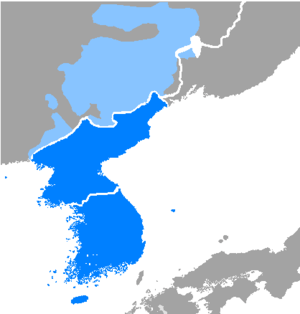Koreanic languages
| Koreanic | |
|---|---|
| Geographic distribution | Korea, Northeast China, Manchuria |
| Linguistic classification | One of the world's primary language families |
| Subdivisions | |
| Glottolog | kore1284[1] |
|
The Koreanic languages | |
The Koreanic languages are a language family consisting of the modern Korean language together with extinct ancient relatives closer to it than to any proposed links. Among extant languages, Korean is considered by most linguists to be a language isolate and by some others as part of the widely rejected Altaic family or the Dravido-Korean languages.[2]
The Jeju language of Jeju Island, considered by some as a dialect of modern Korean, is distinct enough to be considered a language in its own right by other authorities. Some consider that rather than being a language isolate, Korean forms a small language family, together with Jeju.
Classification
The periodization of the historical stages of Korean is as follows:
- Before 1st century: Proto-Korean
- 1st to 10th century: Old Korean
- 10th to 16th century: Middle Korean
- 17th century to present: Modern Korean
Ancient Koreanic languages
Several ancient languages of the Korean peninsula—Silla, Buyeo, Goguryeo, Dongye, Okjeo, Baekje, Gojoseon and Ye-Maek—may have been ancestral to, related to, or part of Old Korean. Two branches are sometimes posited, Buyeo and Han.[3]
In ancient times, Koreanic languages, then established in southern Manchuria and northern Korean peninsula, expanded southward to central and southern Korean peninsula, displacing the Japonic languages spoken there and possibly causing the Yayoi migrations.[4][5][6][7][8] There is disagreement over the protohistorical or historical period during which this expansion occurs, ranging from the Korean Bronze Age period to the Three Kingdoms of Korea period.
Modern Koreanic languages
Modern Korean is traditionally considered a single language. However, Jeju (Cheju) is sometimes classified as a distinct language, for example in the UNESCO atlas on endangered languages. If that is accepted, there are two modern Koreanic languages, Jeju and Korean proper.[9]
Members
- Koreanic Languages (한국어족)
- Ye-Maek language (예맥어)
- Buyeo languages (부여어족)
- Goguryeo language (고구려어)
- Buyeo language (부여어)
- Baekje language (백제어)
- Goguryeo language (고구려어)
- Sillan languages (신라어족)
- Korean language (한국어, 조선말)
- Hamgyŏng dialect (Northeastern dialects; 함경 방언, 동북 방언)
- Koryo-mar (고려말)
- Northwestern dialects (서북 방언)
- Pyongan dialect (평안 방언)
- Hwanghae dialect (황해 방언)
- Yukchin dialect (육진 방언)
- Central dialects.[10] (중부 방언)
- Gyeonggi dialect (Seoul dialect; 경기 방언, 서울말)
- Yeongseo dialect (영서 방언)
- Chungcheong dialect (충청 방언)
- Yeongdong dialects[10] (영동 방언)
- Gyeongsang dialect (Southeastern dialects; 경상 방언, 동남 방언)
- Northern Gyeongsang dialect (북부 동남 방언)
- Southern Gyeongsang dialect (남부 동남 방언)
- Jeolla dialect (Southwestern dialects; 전라 방언, 서남 방언)
- Northern Jella dialect (북부 서남 방언)
- Southern Jella dialect (남부 서남 방언)
- Various dialects
- Zainichi Korean language (재일 한국어)
- Korean language in China (중국조선말)
- Hamgyŏng dialect (Northeastern dialects; 함경 방언, 동북 방언)
- Jeju language (제주어)
- Korean language (한국어, 조선말)
See also
References
- ↑ Hammarström, Harald; Forkel, Robert; Haspelmath, Martin; Bank, Sebastian, eds. (2016). "Koreanic". Glottolog 2.7. Jena: Max Planck Institute for the Science of Human History.
- ↑ Kim, Chin-Wu (1974). The Making of the Korean Language. Center for Korean Studies, University of Hawai'i.
- ↑ Young Kyun Oh, 2005. Old Chinese and Old Sino-Korean
- ↑ Bellwood, Peter (2013). The Global Prehistory of Human Migration. Malden: Blackwell Publishing. ISBN 9781118970591.
- ↑ Vovin, Alexander (2013). "From Koguryo to Tamna: Slowly riding to the South with speakers of Proto-Korean". Korean Linguistics. 15 (2): 222–240.
- ↑ Lee, Ki-Moon; Ramsey, S. Robert (2011). A History of the Korean language. Cambridge: Cambridge University Press. ISBN 978-0-521-66189-8.
- ↑ Whitman, John (2011). "Northeast Asian Linguistic Ecology and the Advent of Rice Agriculture in Korea and Japan". Rice. 4 (3-4): 149–158.
- ↑ Unger, J. Marshall (2009). The role of contact in the origins of the Japanese and Korean languages. Honolulu: University of Hawai?i Press. ISBN 978-0-8248-3279-7.
- ↑ Janhunen, Juha, 1996. Manchuria: an ethnic history
- 1 2 Lee & Ramsey, 2000. The Korean language
